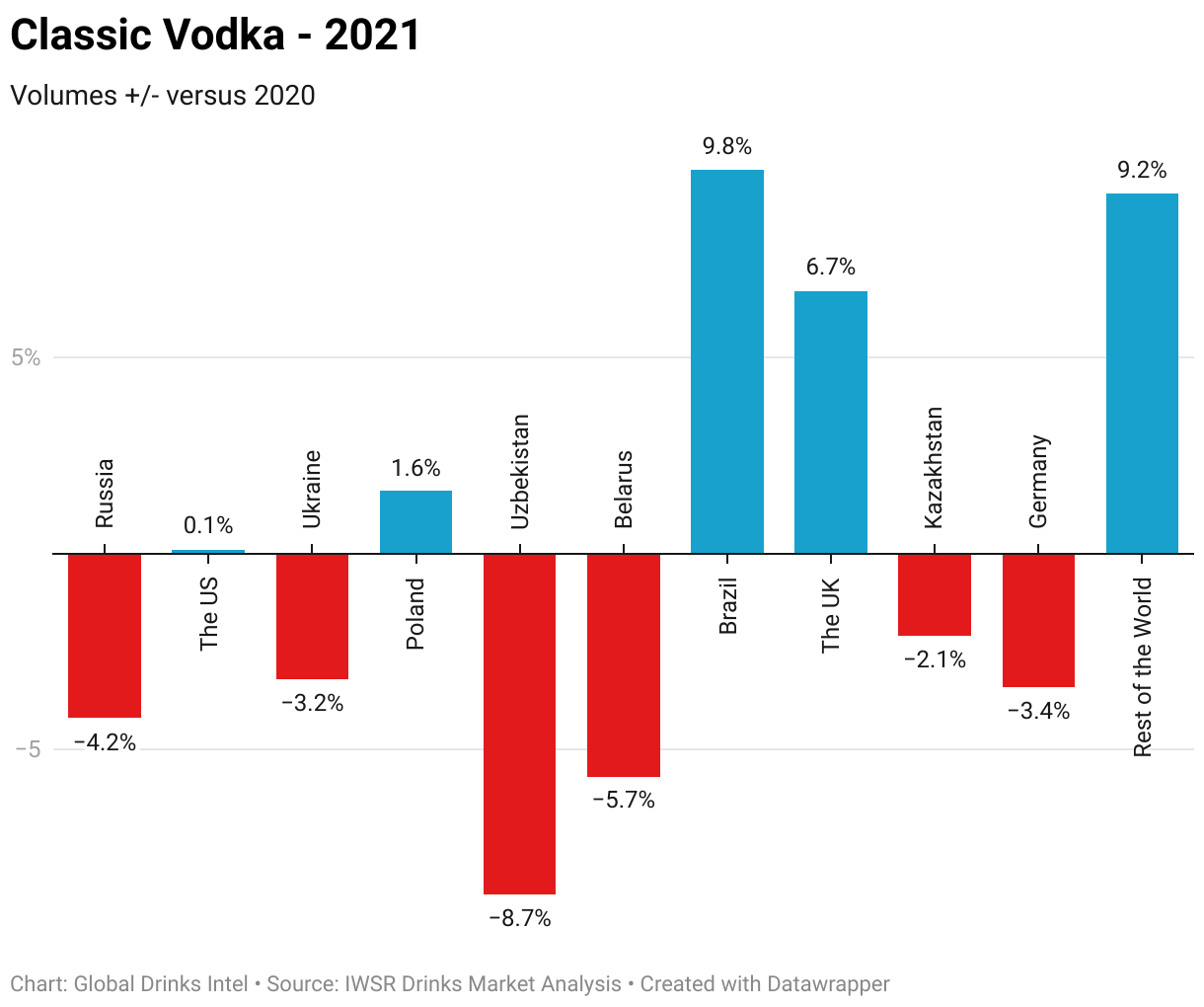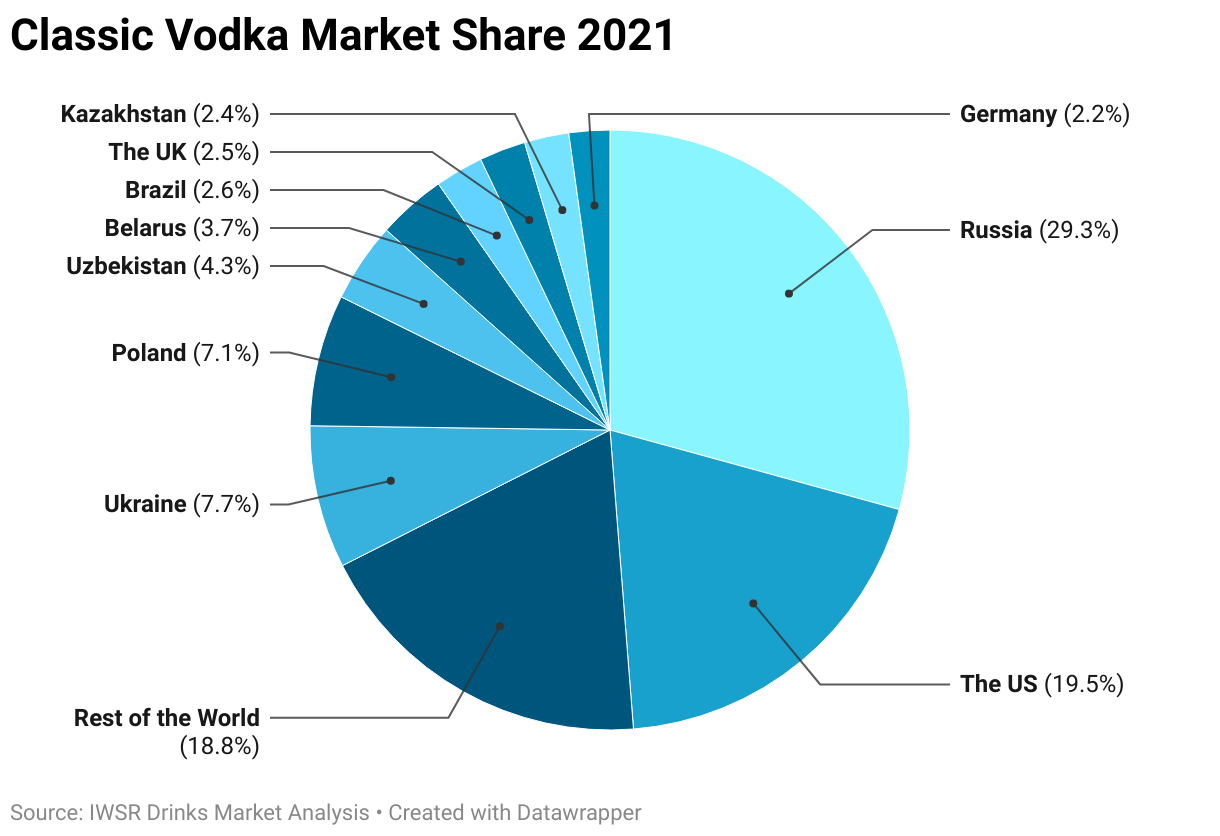How Vodka Brands are Pushing Local Cues to Win Consumers
This article was initially published in the March issue of Global Drinks Intel magazine. For details on how to subscribe, click here.
The war in Ukraine could have been ruinous for the vodka category, but in the last year, brands have been working hard to distance themselves from their Russian origins. Jaq Bayles reports.
Photo by Helena Lopes
With many countries having imposed sanctions on imports of vodka from Russia, some brands have taken steps to assure consumers of their point of origin. Others. meanwhile, have been trading on their ‘localness’ for a long time, helping to dispel the myth that vodka is a Russian-only spirit.
A year on from the start of Russia’s invasion of Ukraine, the effects of sanctions have made little dent in the former’s sales; around 95% of vodka consumption is still concentrated in Russia. At the same time, the sanctions have also played a role in highlighting that most vodka brands consumed in European markets and beyond are already produced outside of Russia.
Smirnoff, for example, had its beginnings in the country, but, according to brand owner Diageo: “Vladimir Smirnoff fled [Russia] during the Revolution and re-established the brand in Europe more than a century ago. Smirnoff has been in America since 1934 and today is proudly made in the US, Canada, Great Britain, Italy, Australia, Jamaica, Brazil, Argentina, India, Indonesia and Kenya.”
Selling Americana to Americans
There is plenty of cachet in promoting a brand to consumers through its provenance, as evidenced by the huge success of Tito’s Handmade Vodka, credited recently by no less than the co-president of Heaven Hill Brands, Allan Latts, with its ability to “sell Americana to Americans”.
Tito’s MD for international, John McDonnell, confirms Latts' observation. “The message that Tito’s is ‘America’s Original Craft Vodka’ is featured in our advertising and promotion," he says. "We also prominently highlight ‘Austin, Texas’ on every bottle of Tito’s sold around the world. And, during the 4 July period, we offer an annual commemorative red/white/blue bottle bag.”
Tito’s was founded by sixth-generation Texan Bert ‘Tito’ Beveridge. “In the mid-1990s, on a plot of land in rural Austin, he built a 998sq ft shack, rigged a pot still with spare parts and created Tito’s Handmade Vodka,” says McDonnell. “To this day, Tito’s is still produced there.”
The sense of patriotism felt by Tito’s domestic consumers, McDonnell believes, is carried with them when they visit other countries, in turn extending brand awareness.
“We have a loyal following in the US, and when Americans travel abroad, they’re excited to be able to find and enjoy their favourite vodka when they’re away from home,” he says. “Word of mouth plays a large role too, so increasingly people from other countries are also discovering Tito’s and making it their vodka of choice.
“An important hallmark of our brand is supporting community organisations and charities, especially those that focus on pet welfare through our ‘Vodka for Dog People’ initiatives. This resonates with people across the globe; consumers appreciate and are loyal to companies and brands that give back.”
Cutting historical ties with Russia
While vodkas made in English-speaking countries may have names that don’t cause any confusion as to their place of origin, others have felt the need to make their positioning is very clear following the start of the Russia–Ukraine war.
“We took steps, in the immediate aftermath of the Russian invasion of Ukraine, to notify trade and consumers, that Moskovskaya Vodka is a 100% European Union sourced and made product,” says global brand director for vodkas at Moskovskaya owner Amber Beverage Group Claire Li. “Because of the brand name, it was especially important for us to explain that we are distanced from Russia.”
Amber reached out to its customers and issued public statements emphasising that the vodka is produced in Latvia, using EU-sourced ingredients and materials. “As a result,” says Li, “people quickly understood the message that despite its historical link to Russia, Moskovskaya is European through and through.
“Amber Beverage Group was one of the first global businesses to announce and offer support to the people of Ukraine,” she adds. “We made a public statement about our support for [them], condemning the attempted invasion, and making donations to humanitarian organisations.
“In spring 2022, we launched a limited-edition bottle in all three Baltic countries - 100% of the profits were donated to the Ukrainian people. The initiative was part of the group’s call for peace and freedom following the invasion. Moskovskaya’s bottle label featured that message."
National brands retain domestic focus
But, what of Russian vodka brands and their current positioning? For at least one brand, there's a strong sense that the idea of provenance remains important within the spirit’s home nation.
Last year, according to Marc Torterat, marketing director for Mamont brand owner Marussia Beverages, 95% of Mamont's sales were in Russia - in line with fellow national brands. “This is obviously linked to the war in Ukraine that has led to a ban on Russian vodkas in some Western markets," Torterat says. "Before the war, however, Russia was already 85% [of Mamont's sales] as a result of a focus and investment.
“Our strategy for the first ten years of existence, has been to build a success story in the domestic market for the brand. With 8% market share, we have achieved our ambition.”
Despite the backlash against Russian vodkas, Mamont continues to champion its provenance. “At the origin of Mamont vodka, we placed the provenance, Siberia, at the heart of our positioning versus other Russian super-premium vodka competitors,” explains Torterat. “We believe provenance is part of consumers’ decision-making process, along with other criteria, especially in markets like Russia and the East European markets where we used to focus.
“This is even more relevant for vodka that has historically-speaking a birthplace, namely Russia. Hence, the decision to write the words Siberia and Russia on our bottle from the very beginning. Recently, we became more specific and now put forward the Altai region [in Siberia] where our distillery is located. This location does not only make sense from a production point of view, it's also consistent and appealing.”
"Consumers want to know where - and how - products are made"
Becky Davies, head of commercial at UK ‘ethical and sustainable’ drinks business Ten Locks - which has Belgian vodka Mary White in its portfolio and has just launched its own brand, Pod Pea Vodka, in the UK - also believes that “provenance is so important, shoppers, just like with their food, want to know exactly what they’re purchasing and consuming”.
Davies is coming from a different viewpoint to Torterat, though: “This was recently highlighted by the backlash against Russian vodka brands, as it gave further proof consumers want to know where and how their products are made in order to make more informed purchasing decisions. Those decisions send a message about who they are, and they want to understand what they’re supporting.
The Edwards 1902 vodka brand was launched two years ago and its premise from the outset has been to champion its UK roots. “A big part of our story - our heritage - is that we are a British distillery, producing ‘soil-to-spirit’ vodka right here in England,” explains co-founder Emma Hamilton.
“We’re really proud to be producing premium vodka here on UK soil. It’s important to take people on a journey with us, ‘from soil to spirit’, educating along the way. Our bespoke bottle, made locally, does a great job of telling our story. The union flag plays a prominent role on the bottle itself, something that carries across our entire portfolio, and is a great indication of origin.”
Being ‘locally made’ feeds into sustainability concerns
Hamilton’s point about being produced locally feeds into current consumer concerns about sustainability and carbon footprints.
Poliakov - another brand with a potentially misleading name but which is produced in France, its main market - “favours proximity in its distribution”. “The grain alcohol used in its manufacture comes 80% from French factories with wheat of French origin," says brand owner La Martiniquaise's international marketing manager, Constance Descamps. "The rest comes from factories based in neighbouring countries, such as Italy, the Netherlands and the UK. The carbon footprint, therefore, is excellent."
This is an area that’s important too for Edwards 1902's Hamilton, who says that sustainability has a vital role to play in the brand's future. “While there are many things we’ve been doing from the start - working with local suppliers wherever possible, offsetting our carbon footprint by using solar power produced on-site - there's still more we can all do to reduce our footprint further, and this is a big part of our journey for 2023 and beyond.
“The rising cost of living, along with the higher prices of many UK-made products, can cause challenges, but these are not barriers. They're something we’re looking to work towards in the future.”
For vodka brand owners, then, promoting local cues is important not only while there's a war going on, but also as a marketing and educational tool in the current consumer climate.
This article was initially published in the March issue of Global Drinks Intel magazine. For details on how to subscribe, click here.



